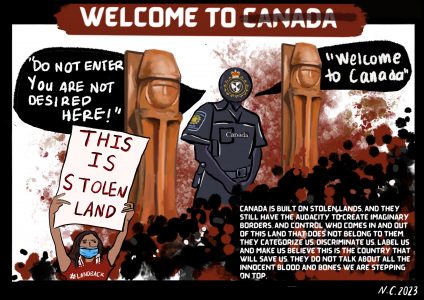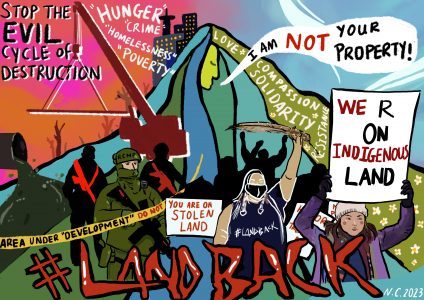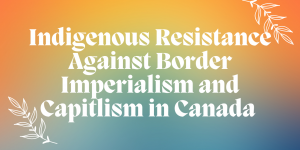Title: Social Justice Art Poster Analysis on #LandBack Indigenous Resistance to Border Imperialism and Settler Colonial Aggressions
Introduction
The following critical analysis is based on two art posters designed using digital tools on Procreate. Poster 1, titled Welcome to “Canada” (fig.1), and poster 2, titled In This Broken World, We Unite to Protect Us (fig. 2) will be used to highlight the brutal aggressions the state performs through border imperialism, capitalism and settler colonial behaviour which impact the lives of billions of people from the Global South, Indigenous communities and also Mother Earth. While both posters showcase the violence the nation causes to the people and the environment in the name of “development”, they also serve to portray the powerful resistance shown by Indigenous organizers such as #LandBack movements, and their commitment to protecting our planet as well as human beings, through love, solidarity, compassion and forgiveness.
In working on these art pieces, as a settler myself, I am embracing the discomfort that comes with recognizing my status on this land and the privilege I have gained from the dispossession of Indigenous people. Through this critical analysis, I hope other settler readers can see the complexity and severity of our situation and feel that same discomfort and understand the importance of truly listening to Indigenous leaders. I want to emphasize that reading and educating ourselves is the bare minimum we can do; we need to work harder to stand in solidarity with Indigenous communities. These art posters are my own attempt at representing Indigenous struggles and resistance through visual storytelling, it does not replace Indigenous voices and art, but I hope these posters are provocative and thought-inducing.
PART 1: Welcome to “Canada”, a Broken Nation that Conquers through Divisiveness

In this first poster, I will highlight two main elements: 1) Colonial multiculturalism and false ‘reconciliation’ through the instalment of decontextualized Indigenous artwork that depicts Indigenous communities as ‘other’ and ‘extinct’ and 2) how border imperialism and racial capitalism is used as a tool to create divisiveness and disharmony while breaking the natural interdependence cycle of survival. Both of these themes will then introduce the reasons why it is essential for settlers to become active allies to Indigenous communities by following their resistance. The sculptures I depicted in Fig. 1 represent the artwork by artist Susan Point, titled Musqueam Welcome Figures (1996) found at the arrival area at YVR airport in so-called “Vancouver”, BC (fig. 3). Canada prides itself on being a ‘peaceful’ and ‘multicultural’ nation, often differencing itself from their neighbouring state, in the hopes to attract a larger population of very selective “desirable” immigrants into the country, which are mostly of white descent. The Musqueam Welcome Figures at YVR are the first thing most international travellers get to see upon arriving. In my poster, I wanted to contrast these sculptures to the very monotone and dark aspect of the environment they are placed in. The black border around the poster, for instance, represents a form of ‘contained or utopian reality’ presenting the idea that in the eyes of colonialism, “indigeneity has been allowed a place in liberal society so long as it can be harmonized or reconciled with the constitutional framework of the liberal state” (Simpson et al. 296), meaning that these pieces of artwork are placed in strategic locations and used as tools of false ‘reconciliation’. These performative acts of reconciliation further encourage settler behaviour among newcomers, and misinforms people by creating a distraction. I used black, white and red coloured dots to represent the mass genocide of Indigenous peoples and the destruction of the land. Upon stepping into that airport, everyone becomes complicit in these acts even though they are not aware of it. These colours are used to highlight the difference between the organic nature of the wood used in the carving of this sculpture with the sterile and lifeless environment of the customs hall. Canada often places decontextualized Indigenous art pieces as “illustrative of a ‘vanishing race’” (Mawani 36), which contrasts with the “progressive” look of the airport. It renders the Musqueam people as an atemporal and static community that does not fit the ‘modern’ Canadian society. This environment serves as a “working model of a culture forged by the meeting of the ‘dominant’ and the ‘other’ where the dominant is presented by the physical space of the airport and the other is represented by the art of the Musqueam Salish people within the space” (Leddy 2). Indigenous art is used as a distraction to hide all the violence that Canada commits towards the people and land. This is how “reduction of First Nation’s people occurs when their art is left to stand in for them; the objects replace the people” (Leddy 55).
The only humans depicted on this poster are the immigration officer who wears the face of the oppressing systems created by border imperialism and a #LandBack activist holding a sign that says “This is stolen land”. Once again, the contrasts in the colours are used to highlight the lack of empathy and compassion for those wearing state uniforms can be. The immigration officer is the visual representation of border imperialism, but they are just pawns of the system, blinded by the belief that they are there to be the protectors of their country.
The customs hall is a place where you go to be judged: you are either welcomed into Canada or not. This sense of divisiveness and competitiveness roots in capitalism and neo-liberal ideas of modern economy and survival. You need to be “worthy” in the eyes of capitalism to be granted entrance into this country. “Canadian Newcomers become active participants in promoting the colonizer agenda and ultimately become colonizers themselves” (Khan et al. 149). This realization alone can be a big step into transformative action as settlers. We are part of the evil cycle of destruction. Colonial multiculturalism makes Canada an ‘inviting’ and welcoming place to many individuals from the Global South seeking “better” life opportunities. While racial capitalism destroys Mother Earth causing more displacement of these individuals to have to look for ‘better opportunities’ in the Global North, doing the jobs that white people do not want to do and further damaging Indigenous communities and the land. “The role of Western imperialism in dispossessing communities in order to secure land and resources for state and capitalist interests, as well as deliberately limited inclusion of migrant bodies into Western states through processes of criminalization and racialization that justify the commodification of their labor” (Walia 23). This is an evil cycle of mass displacement, genocide, and violence. But there is hope for the future, and hope and strength can be found in land defenders who are always there but only (in)visible to some.
PART 2: In This Broken World, We Unite to Protect Us – Learning from Indigenous resistance and activism

In Fig. 2, I wanted to highlight that while evil systems of oppression exist and will try to keep existing to attempt to vanish Indigenous communities, Indigenous resistance and activism is NOT invisible. It is powerful, colorful, lifeful, resilient and strong. As Lowman & Barker explain, decolonization “is not about centering colonialism, but rather about focusing on the resiliency and vibrancy of Indigenous peoples” (112). In this part of the analysis, I will focus on exploring the importance of Indigenous resistance and #LandBack movements and its goal to protect this land and people who find a home on her.
Resistance is love, solidarity, unity and compassion. This is represented by the diverse colours used in Fig. 2 as opposed to Canadian modern architecture in the city or in the airport where everything looks monotonous, lifeless and assimilated. In the center of the poster, I decided to represent Mother Earth as a mountain that is part of the land, the sky, the water and us, the people who find a home on her. “Canada” is not property, this nation is part of Mother Earth. WE are part of Mother Earth. We cannot build invisible borders on a relative, we cannot abuse a relative yet WE abuse Mother Earth in the name of ‘development’. In such troublesome times, where the world is so broken, we cannot listen to the politicians and capitalist leaders that promise us better futures when we have seen they have failed this land and the people again and again. It is now when we need Indigenous leaders more than ever. Pieratos et al. write that “Resistance and movement building are within [their] ancestral memory as Indigenous people, and [their] very survival is because of that historic resistance” (53). Indigenous communities have lived through several struggles since the start of colonisation, and they are still here and they keep fighting, which makes them natural leaders who understand that “collective liberation is not achievable unless movements coalesce to influence systemic changes in the policies of this country and beyond” (Pieratos et al. 57). We have done enough damage by not listening to Indigenous knowledges about the natural cycles of living and giving in this world. Modern times environmental settler activism lacks this understanding of interdependence with the land and regarding the land, and nature and animals as our relatives. This type of movement is not radical enough to transform and heal, since they do not stop the evil cycle of destruction caused by capitalism, instead, want to keep being part of the same system that keeps oppressing others. We need Indigenous knowledges and leaders to guide these movements. It is not enough to “reconcile” and place artwork around the city, “Land Back needs to happen so that all other aspects of Indigenous livelihood can return with it.” (Pieratos et al. 51). It is only through Indigenous understandings of the land that we can find an alternative to this mass destruction in progress. The #LandBack movement website describes that “To truly dismantle white supremacy and systems of oppression, we have to go back to the roots. Which, for us, is putting Indigenous Lands back in Indigenous hands”. The global crisis is killing us all, and we have already run out of time. The #LandBack movement is a model example of how decolonization can be operational, real and tangible because “Indigenous leadership style [has] the power to combine narratives and policy agendas and reimagine systems that are egalitarian, regenerative, and flexible” (Pieratos et al. 50). Movements such as #LandBack are effective as they truly understand the concept of interdependence between humans, land, fauna and flora. This kinship network of “gift-giving and gift-receiving responsibilities to each other” (Whyte 127) is our natural cycle of survival that the capitalist agenda keeps disrupting, causing the natural interdependence to break. Capitalism refuses to take responsibility for its action and it only takes more than it can ever give back.
Settler colonial behaviour, as represented in Fig. 2 as the contamination of water, deforestation and “development”, is unsustainable and it is driving us toward the extinction of our kind. Even through all this destructive behaviour, the land, the water, and the dirt, Mother Earth has the strength to resist and keep us alive. She is doing her part and we also have the responsibility to do ours to help her and help us survive. While in poster 1 I explained how capitalism and neo-liberalism try to divide and conquer by creating tension between immigrants and othering Indigenous peoples by replacing the people with tokenized objects, Indigenous grassroots movements work the opposite way and they value unity and solidarity and they practice listening and forgiving. Activists depicted in Fig. 2 were inspired by Native American protesters in Keystone, S.D. ahead of Donald Trump’s visit in July of 2020 and other #LandBack activists. I wanted to depict real people who have fought on the front lines of these protests, and who have put their lives at risk to protect this land. They are the real people who we need to see more of, not sculptures and static artwork that are decontextualized around the city. Even though land defenders are fighting to get their land back they are not fighting in the name of ‘revenge’ or ‘punishment’. They forgive the officers as individuals but they fight the oppressive systems that drive them.
In this poster, even though RCMP officers are putting ‘yellow tape’ around areas and denying access to areas of land, they are all still a very small part of what makes our whole world. They are still stepping on the same soil and breathing the same air as Indigenous people and yet they remain ignorant of the way Mother Earth is keeping THEM alive. We cannot remain ignorant of this knowledge, because in ignorance comes compliance, and remaining compliant in a time of global crisis means a death sentence. I hope this poster inspires action and self-reflexivity, not compliance. #LandBack movement highlights the symbiotic relationship with Mother Earth and our responsibility to protect her so she can protect us. “It is acknowledging that only when Mother Earth is well, can we, her children, be well” (LandBack.org).
Conclusion
Our world is in deep trouble and we need to stop following empty promises the state governors and politicians throw at us. They might want us to believe in “reconciliation” but the truth is that they do not get to choose when to reconcile, they do not get to walk out of this all without being accountable for their actions. Indigenous struggles are our problem to solve too. As settlers in this nation, we need to understand our involvement in Indigenous struggles and feel the discomfort needed to truly take responsibility and be accountable for our actions. In becoming allies to movements such as #LandBack and other grassroots organizing movements, we can help Mother Earth and the Indigenous people and stop the genocide of humankind. “We are digging deep and leaning into the empowering work of decolonization because our lives depend on it” (Pieratos et al. 57). Instead of taking a photograph of Indigenous art around the city, let decontextualized Indigenous artwork remind us of our role as settlers and inspire continuous discomfort and call for action. We need #LandBacnk.
References
Khan, Sarah, et al. “Paying Our Dues: The Importance of Newcomer Solidarity with the Indigenous Movement for Self-Determination in Canada.” The Canadian Journal of Native Studies, vol. 1, 2015.
Leddy, Shannon C. Tourists, Art and Airports: The Vancouver International Airport as a Site of Cultural Negotiation. University of British Columbia, 1997.
Lowman, Emma Battell, and Adam J. Barker. Settler: Identity and Colonialism in 21st Century Canada. Fernwood Publishing Co., Ltd, 2015.
Musqueam Welcome Area | YVR. https://www.yvr.ca/en/about-yvr/art/musqueam-welcome-area.
Pieratos, Nikki A, et al. “Land Back: A Meta Narrative to Help Indigenous People Show up as Movement Leaders.” Leadership, vol. 17, no. 1, 2020, pp. 47–61., https://doi.org/10.1177/1742715020976204.
Simpson, Jennifer S., et al. “Multiculturalism, Colonialism, and Racialization: Conceptual Starting Points.” Review of Education, Pedagogy, and Cultural Studies, vol. 33, no. 4, 2011, pp. 285–305., https://doi.org/10.1080/10714413.2011.597637.
Walia, Harsha. “What Is Border Imperialism?” Undoing Border Imperialism, vol. 6, AK Press, Edinburgh, 2014, pp. 22–48.
Whyte, Kyle. “Settler Colonialism, Ecology, and Environmental Injustice.” Indigenous Resurgence, 2022, pp. 127–146., https://doi.org/10.2307/j.ctv2vr8tm0.11.

Our world is in deep trouble and we need to stop following empty promises the state governors and politicians throw at us. They might want us to believe in “reconciliation” but the truth is that they do not get to choose when to reconcile, they do not get to walk out of this all without being accountable for their actions. Indigenous struggles are our problem to solve too. As settlers in this nation, we need to understand our involvement in Indigenous struggles and feel the discomfort needed to truly take responsibility and be accountable for our actions.